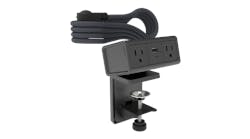Because some parts of a school facility might age and deteriorate out of view of those using the building, administrators might be tempted to put off improvements or let conditions slide. But when the floors in a school begin to go, the problem is evident to every student and staff member whose heels come in contact with the surface.
When schools decide their flooring needs to be replaced, the first issue to be resolved is what type of flooring should be used. That will depend on how the space in question is used.
“Flooring should be durable to withstand heavy use without requiring frequent replacement,” says the Collaborative for High Performance Schools Best Practices Manual.
For main corridors and other heavy-traffic parts of a school, the durability of hard-surface flooring such as vinyl composition tile (VCT) or terrazzo make those products a good choice. Resilient flooring such as VCT is cleaned more easily than carpet and typically has a longer life.
“Vinyl composition tile is the most commonly used flooring material for non-carpeted areas in schools due to its long life, low maintenance requirement and moisture-resistant properties,” the Best Practices Manual says.
In classrooms and libraries, where increased comfort and better acoustics create more ideal conditions for learning, carpeting may be a better choice.
“Carpeting offers acoustical and comfort benefits that are generally not available with other flooring choices,” the Best Practices Manual states.
Schools also may want to consult with the instructors that will be using a particular space to see which floor surfaces they prefer.
Choosing carpet tiles instead of broadloom carpet will allow a school to replace worn or damaged areas without having to get rid of an entire carpet. However, tiles may be more subject to vandalism by students, and spills on carpet tiles may cause moisture to seep in between the joints and lead to mold or other indoor-air-quality problems.
“One good choice for schools is a low-nap, all-nylon carpet, which is less attractive to dust mites and mold,” the manual says.
Once carpeting has been installed in a school setting, the area should be aired out for at least 72 hours. The manual recommends that if the facility has central HVAC, the ventilation supply should be on, the return grilles should be closed, and windows should be opened.
Before choosing which type of flooring is most appropriate, administrators should factor in what kind of cleaning and maintenance the surface will require. The Best Practices Manual states that if a school cannot provide the level of maintenance to keep carpets clean, it should select a different floor surface.
A poorly maintained carpet can collect dirt, pollen, mold spores and pesticides, and lead to health problems for building occupants.
“Clean carpet does not support mold growth …” says the Carpet and Rug Institute. “The key to eliminating mold indoors is to keep schools clean and dry.”
NOTABLE
$5 to $10
Per square foot, the typical cost of terrazzo installation.
$2.20 to $3
Per square foot, the typical cost of a nylon carpet installation.
$6 to $12
Per square foot, the typical cost of a ceramic tile installation.
10 to 15
In years, the expected life of carpeting in a school.
40 to 80
In years, the expected life of ceramic tile in a school.
Entire life of building
Expected life of terrazzo in a school.
Source: Collaborative for High Performance Schools Best Practices Manual.

